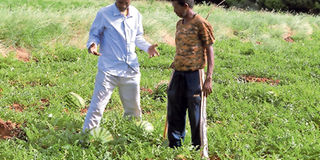Why Mandera melons are sweeter

Agriculture officer, Adan Alaso (left) with watermelon farmer, Ibrahim Mohammed, in the latter's farm in Mandera. Soils in the county are rich in minerals that sweeten the fruits, giving them a unique taste, according to Mr Alaso. PHOTO | MANASE OTSIALO | NMG
What you need to know:
- Mohamed has divided his 10-acre farm into five portions, with each section holding different crops that include onions, sukuma wiki (collard greens) and tomatoes.
- Soils in Mandera are rich in minerals that sweeten the fruits, giving them a unique test, according to Adan Alaso, an agricultural extension officer.
- A melon plant has both male and female flowers; the male sprouts first followed by the female ones that are pollinated by bees and other insect pollinators and fruit develops from the female flower.
- To know whether the watermelons is ripe for harvest, Mohamed says the rind (outer layer/cover) hardens.
If you have ever tasted very sweet watermelons in the market, chances are that they may have come from Mandera.
The area produces some of the sweetest watermelons in the market, thanks to a good warm weather and fertile soils.
Increased demand for the fruits from the region has pushed many residents like Ibrahim Adan Mohamed into melon farming.
Mohamed has divided his 10-acre farm into five portions, with each section holding different crops that include onions, sukuma wiki (collard greens) and tomatoes.
The most eye-catching part, however, is the watermelon plantation, which is lush green with huge fruits.
“I have been growing melons since 2012 and the yields have been good. I ventured into the farming after I learnt from a fellow farmer that the crop does well in the region.”
Mohamed notes melons are relatively cheaper to produce on the farm because the seeds are directly planted in the soil and need less water as compared to other crops.
“When planting watermelon seeds, it is important to take into account the amount of sunlight the plant will receive as they require a minimum of six hours of sunlight a day,” explains the farmer, who grows the Sukari F1 variety.
Watermelons begin to develop runners two weeks after germination.
“You then have to cultivate the farm and spray to keep off pests and diseases. Watering continues as sprouts start spreading once or twice week,” says Mohamed, who sources his water from the nearby River Daua.
He stops irrigation when the crop is a few weeks to maturity to avoid waterlogging and rotting of the fruits. This allows the plant to sweeten naturally.
Soils in Mandera are rich in minerals that sweeten the fruits, giving them a unique taste, according to Adan Alaso, an agricultural extension officer.
DRY WEATHER CONDITIONS
“When the plant is three weeks old, a farmer should apply fertiliser to ensure steady and sturdy growth. The best fertilisers should contain more nitrogen than potassium and phosphorous. The use of nitrogen-rich fertilisers should reduce as the plant matures around the time it starts blossoming and the flowers are visible,” he offers.
A melon plant has both male and female flowers; the male sprouts first followed by the female ones that are pollinated by bees and other insect pollinators and fruit develops from the female flower, Alaso explains.
Mulching can be done in the early stages of the crop growth as it ensures that the soil water content is retained longer.
While Mohamed grows watermelon seeds directly in the soil, Alaso says one can still germinate them in a nursery before transplanting to the field 1.5m apart.
“Good spacing ensures each seedling spreads out without facing competition on the farm,” he says.
Common diseases include leaf spot, dumping off, blight and powdery mildew.
“Diseases are not common in Mandera because of the dry weather condition but the biggest menace is pests,” says Mohamed, citing porcupines, monkeys and warthogs, which attack the fruits. He covers mature fruits with dry grass to hide them from animals.
To know whether the watermelons is ripe for harvest, Mohamed says the rind (outer layer/cover) hardens.
“When tapped, the fruit sounds as though it is hollow and may show yellow spots on the lower side that is in contact with the ground.”
He sells the fruits mainly outside Mandera, including in Nairobi, Mombasa and Nakuru, as locals do not buy them.
“I sell to middlemen who come with lorries at between Sh50 and Sh150,” says the farmer, noting he is currently readying to harvest 20,000 fruits from his two acres.




